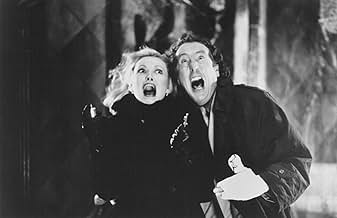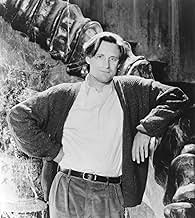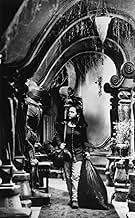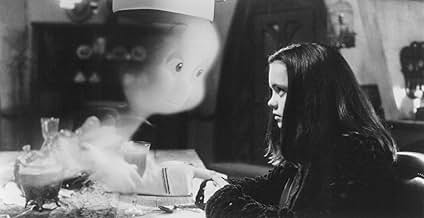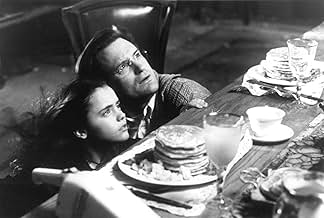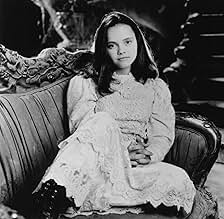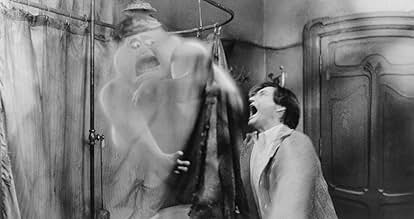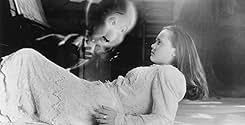Un experto de lo paranormal y su hija se mudan a una casa abandonada habitada por tres fantasmas perversos y uno adorable.Un experto de lo paranormal y su hija se mudan a una casa abandonada habitada por tres fantasmas perversos y uno adorable.Un experto de lo paranormal y su hija se mudan a una casa abandonada habitada por tres fantasmas perversos y uno adorable.
- Dirección
- Guión
- Reparto principal
- Premios
- 5 premios y 5 nominaciones en total
Fred Rogers
- Mr. Rogers
- (metraje de archivo)
- (as Mr. Rogers)
Doug Bruckner
- Reporter
- (voz)
- (as Douglas J.O. Bruckner)
Joe Nipote
- Stretch
- (voz)
Joe Alaskey
- Stinkie
- (voz)
Brad Garrett
- Fatso
- (voz)
Reseñas destacadas
The 1995 film Casper came in the wake of a number of high profile films based on older properties. Some, like The Addams Family, Maverick, and Flintstones managed to achieve impressive box office and/or critical praise while others such as The Beverly Hillbillies, Car 54, Where Are You?, or Richie Rich were met with derision and scorn from critics and audiences. Casper falls somewhere towards to the upper end of the spectrum making it better than Flintstones by a considerable margin, but not nearly as funny or memorable as The Addams Family.
Casper, based on the Harvey Comics character turned star of Famous Studios' series of theatrical shorts, follows the titular friendly ghost as he deals with the schemes of heiress Carrigan Crittenden(played delightfully over the top by Cathy Moriarty), his brash abrasive uncles The Ghostly Trio, a grieving paranormal psychologist and his outsider daughter, and a whole host of shenanigans from either the living or the dead. Needless to say there's elements I'm leaving out because they're either resolved to quickly to be of merit or contribute nothing to the movie.
First the good. The performances are energized and give this movie the life it needs to justify itself. Regardless of the quality of the material, everyone here is bringing their A game be it Eric Idle as the put upon yes man, Bill Pullman as the quirky paranormal psychologist, Christina Ricci as the outsider daughter, and even Devon Sawa as Casper. Helping the performances is the amazing production design which helps create an incredible looking haunted house that feels almost like Disney's Haunted Mansion ride with more polish(though sometimes the film does feel a bit too much like a theme park ride in certain segments). The effects to create the ghosts are also quite impressive for the time, as they're designed very similarly to Jim Carrey's effects from The Mask with cartoonish exaggerations and elasticity that make them feel dynamic and alive(no pun intended).
The Negatives. The script has problems finding pacing and direction. There's no one single story pulling the characters from scene to scene, the instigating plot involving Carrigan looking for a secret Treasure takes up the first 10 minutes of the movie and then is brought back for maybe 12 minutes towards the end of the movie. Scenes just kind of go from one to the next as there's really no callback style jokes or running gags linking the comic set pieces together, nor are there really character building scenes as they feel like islands without much thought to placement in a larger narrative.
The movie is written by Sherri Stoner and Deanna Oliver, better known for their work on shows like Animaniacs and Tiny Toons Adventures and there's definitely a lot of their comic style on display with the Ghostly Trio who spout pop culture references and insults(with a surprising amount of hells and damns thrown in but that's honestly not much of a concern for me), but much of their comic scenes feel at odds with other scens that try to seriously address the nature of death and grief(including a very well staged scene where Casper looks over his sled remembering how he died) and the tone will whiplash from Snarky, to Zany, to serious sometimes within only a few seconds.
Casper is the kind of movie you wish were better than it is. There's clear talent on display be it the production design, the direction, the acting, and even the special effects, but it's unfortunately weighed down by a lack of focus and can feel like a scattershot imitator of Beetlejuice with its teeth filed down. It's got good moments, they just don't come together as well as they should.
First the good. The performances are energized and give this movie the life it needs to justify itself. Regardless of the quality of the material, everyone here is bringing their A game be it Eric Idle as the put upon yes man, Bill Pullman as the quirky paranormal psychologist, Christina Ricci as the outsider daughter, and even Devon Sawa as Casper. Helping the performances is the amazing production design which helps create an incredible looking haunted house that feels almost like Disney's Haunted Mansion ride with more polish(though sometimes the film does feel a bit too much like a theme park ride in certain segments). The effects to create the ghosts are also quite impressive for the time, as they're designed very similarly to Jim Carrey's effects from The Mask with cartoonish exaggerations and elasticity that make them feel dynamic and alive(no pun intended).
The Negatives. The script has problems finding pacing and direction. There's no one single story pulling the characters from scene to scene, the instigating plot involving Carrigan looking for a secret Treasure takes up the first 10 minutes of the movie and then is brought back for maybe 12 minutes towards the end of the movie. Scenes just kind of go from one to the next as there's really no callback style jokes or running gags linking the comic set pieces together, nor are there really character building scenes as they feel like islands without much thought to placement in a larger narrative.
The movie is written by Sherri Stoner and Deanna Oliver, better known for their work on shows like Animaniacs and Tiny Toons Adventures and there's definitely a lot of their comic style on display with the Ghostly Trio who spout pop culture references and insults(with a surprising amount of hells and damns thrown in but that's honestly not much of a concern for me), but much of their comic scenes feel at odds with other scens that try to seriously address the nature of death and grief(including a very well staged scene where Casper looks over his sled remembering how he died) and the tone will whiplash from Snarky, to Zany, to serious sometimes within only a few seconds.
Casper is the kind of movie you wish were better than it is. There's clear talent on display be it the production design, the direction, the acting, and even the special effects, but it's unfortunately weighed down by a lack of focus and can feel like a scattershot imitator of Beetlejuice with its teeth filed down. It's got good moments, they just don't come together as well as they should.
After you get through the stresses of your day... your job, the hassles of daily life, all the stressers that are out there daily, it seems great to sit back and enjoy something that will take you out of that for a little while. If you watch the news and read the papers every day like I do, it gets to you after a while...the young soldiers being killed in Iraq, all the election BS that we are being bombarded with right now...all or most of the news is downright depressing. That creates an important place for a movie like this...one that can make your life a little less serious for a while. I've always been a Christina Ricci fan, going back to the Addams Family when she was only 11 years old. She was a great actress even at that young age. You could tell that she would go far as an actress. The personality was there...it set her apart from her peers. At the age of 15, she continues to do a great job in Casper...she is very believable.
Sometimes, in this troubled world where violence and negative things seem to be the norm, a nice little movie like this can go a long way toward making your day a little brighter. Some of my other "feel good" movies are Patch Adams, all the Superman movies, the Robocop series, and good old Babe. Thanks for reading this. Feel free to reply with an email.
Sometimes, in this troubled world where violence and negative things seem to be the norm, a nice little movie like this can go a long way toward making your day a little brighter. Some of my other "feel good" movies are Patch Adams, all the Superman movies, the Robocop series, and good old Babe. Thanks for reading this. Feel free to reply with an email.
I don't view films as if I'm watching them as the intended audience; I watch them for myself. And that's why I found it odd at how engrossed I was when I watched this film for the first time at the age of eighteen. Aside from the great gothic flair of the mansion, two superbly placed cameos, and nice laughable black humour from the "trio," the film took off because of its emotional core. It's something that a youngster can really get into, but also anyone who finds it sad that a child can die. When Casper plays with his toys, I just wanted to start crying. This eternal child--lost and stuck in an age of mystery and wonder. And yet, he's smitten with a girl--he's starting to go through puberty. And it's just so sad . . . and beautiful.
And then there's the father, and his sway into the afterlife, his daughter's plight, her struggle with her wish to help Casper. It's all so simple and written for kids, but I was so engrossed by the romanticism of it all.
The villains mostly butt into the greatness of all of it, but you just have to grant that in a kid's picture. And now comes my but . . . in the end, when the mother does appear, she's supposed to be this amazing, angelic, deux es machinal, she floats through the stain glass window, her long hair flows around her, her gown flows all around her but--what the hell! why is her dress such a deep red!? she looks like satan! Oh well. Bad costume choice made a really bad moment. But mostly, I loved this film for it's good parts, despite the childishness of much of it.
And then there's the father, and his sway into the afterlife, his daughter's plight, her struggle with her wish to help Casper. It's all so simple and written for kids, but I was so engrossed by the romanticism of it all.
The villains mostly butt into the greatness of all of it, but you just have to grant that in a kid's picture. And now comes my but . . . in the end, when the mother does appear, she's supposed to be this amazing, angelic, deux es machinal, she floats through the stain glass window, her long hair flows around her, her gown flows all around her but--what the hell! why is her dress such a deep red!? she looks like satan! Oh well. Bad costume choice made a really bad moment. But mostly, I loved this film for it's good parts, despite the childishness of much of it.
I saw it first for Christina Ricci and, I admitt, I was seduced by her work.
I saw it as a beautiful and, for many reasons, useful film about friendship.
And the scene of dance of Casper and Kat remains the basic good point , with fairy tale sparkles.
A film for entire family, preserving a sort of very fair ingenuity, reminding small truths and defining , in smart manner, the lost of loved other.
Sure, a naif comedy.
But charming in profound sense, not less for gentle remind of the real needs of every from us.
I saw it as a beautiful and, for many reasons, useful film about friendship.
And the scene of dance of Casper and Kat remains the basic good point , with fairy tale sparkles.
A film for entire family, preserving a sort of very fair ingenuity, reminding small truths and defining , in smart manner, the lost of loved other.
Sure, a naif comedy.
But charming in profound sense, not less for gentle remind of the real needs of every from us.
Forget the story. Forget the characters; forget even the kids and rent this just to be able to see Whipstaff Manor.
For me a film can be rewarding if just one element (in practical terms, it has to be an element I can recognize) is best in class. Here, it is the absolutely engaging set.
At the end of the 19th century, a style of art, essentially a fad, swept over Europe: Art Nouveau. This focused on natural forms and continuous lines. Done well in drawing and sculpture, its quite charming. At the same time, there was a crisis in architecture as the first real architects sought solutions to how internal space affects the psyche. For only a decade or so, architects tried to employ art nouveau in their work.
The problem is that the two just don't naturally mix: it's as if someone tried to do a swimmingpool production of Hamlet. But two geniuses partly succeeded in a few experiments: Horta in Brussels and Gaudi in Barcelona. In their lives their experiments were rejected by the public and critics. Today, they are among only a few valued gems of modern architectural history we have.
So much for background. What we have in Whipstaff Manor is a reworking of Gaudi, with some elements of Horta in entry and staircase. This is notable for a couple reasons:
---The primary mission of a film is to convey a tone, ideally an unfamiliar one. Sometimes cinematography is the tool of reliance, sometimes costumes, sometimes surreal plot twists, rarely acting posture. Rarely, rarely is the set the star. The goal of Gaudi was to (in a very literal sense) raise spirits by the form of the space. See how you feel in the bedroom/corridor and `livingroom' spaces. The attic was done by a lesser talent and the cellar isn't part of this discussion. But the main house draws on some deeply spooky center of the mind.
---The second notable comment is the sheer difficulty of what the set designers have done. Gaudi, an absolute master, had difficulty pulling off what he did. Here, the Casperites had an even greater challenge: when I go in a space, the relationship between me and the space is intimate; just a simple dialog. But when the space is presented through a medium, the designers have to dramatically exaggerate elements so the combined effect appears `normal.' Its the same as with what actors must do as compared to ordinary people you encounter; but an environment is more complex, more multidimensional, less semiotically loaded than a person. Mastering this greater palette of form is remarkable, and that's before you even accommodate the physical needs of production (camera placement, sound wiring...)
Check this out; it's interesting. Just based on the set, I place this in my best films list.
For me a film can be rewarding if just one element (in practical terms, it has to be an element I can recognize) is best in class. Here, it is the absolutely engaging set.
At the end of the 19th century, a style of art, essentially a fad, swept over Europe: Art Nouveau. This focused on natural forms and continuous lines. Done well in drawing and sculpture, its quite charming. At the same time, there was a crisis in architecture as the first real architects sought solutions to how internal space affects the psyche. For only a decade or so, architects tried to employ art nouveau in their work.
The problem is that the two just don't naturally mix: it's as if someone tried to do a swimmingpool production of Hamlet. But two geniuses partly succeeded in a few experiments: Horta in Brussels and Gaudi in Barcelona. In their lives their experiments were rejected by the public and critics. Today, they are among only a few valued gems of modern architectural history we have.
So much for background. What we have in Whipstaff Manor is a reworking of Gaudi, with some elements of Horta in entry and staircase. This is notable for a couple reasons:
---The primary mission of a film is to convey a tone, ideally an unfamiliar one. Sometimes cinematography is the tool of reliance, sometimes costumes, sometimes surreal plot twists, rarely acting posture. Rarely, rarely is the set the star. The goal of Gaudi was to (in a very literal sense) raise spirits by the form of the space. See how you feel in the bedroom/corridor and `livingroom' spaces. The attic was done by a lesser talent and the cellar isn't part of this discussion. But the main house draws on some deeply spooky center of the mind.
---The second notable comment is the sheer difficulty of what the set designers have done. Gaudi, an absolute master, had difficulty pulling off what he did. Here, the Casperites had an even greater challenge: when I go in a space, the relationship between me and the space is intimate; just a simple dialog. But when the space is presented through a medium, the designers have to dramatically exaggerate elements so the combined effect appears `normal.' Its the same as with what actors must do as compared to ordinary people you encounter; but an environment is more complex, more multidimensional, less semiotically loaded than a person. Mastering this greater palette of form is remarkable, and that's before you even accommodate the physical needs of production (camera placement, sound wiring...)
Check this out; it's interesting. Just based on the set, I place this in my best films list.
¿Sabías que...?
- CuriosidadesThis is the first feature film to have a fully computer-generated visual effects character in a leading role.
- PifiasIn the classroom, Casper ties Amber's shoelaces together before anyone else's. When Amber stands up to protest the party being at Kat's house instead of hers, she doesn't trip over them. She sits back down, but when the bell rings and she gets up, she trips.
- Citas
Dr. Raymond Stantz: [runs out of the house frantic] Who you gonna call? Someone else.
- Créditos adicionalesThe globe in the Universal logo fades into a full moon above Whipstaff Manor.
- ConexionesEdited into Casper: Deleted Scenes (2003)
- Banda sonoraCasper The Friendly Ghost
Written by Mack David and Jerry Livingston
Performed by Little Richard
Produced by Richie Zito and Little Richard
Arranged by Richie Zito
Selecciones populares
Inicia sesión para calificar y añadir a tu lista para recibir recomendaciones personalizadas
- How long is Casper?Con tecnología de Alexa
Detalles
- Fecha de lanzamiento
- País de origen
- Sitio oficial
- Idioma
- Títulos en diferentes países
- Casper: el fantasma amigable
- Localizaciones del rodaje
- Rockport, Maine, Estados Unidos(Anonymous)
- Empresas productoras
- Ver más compañías en los créditos en IMDbPro
Taquilla
- Presupuesto
- 55.000.000 US$ (estimación)
- Recaudación en Estados Unidos y Canadá
- 100.544.179 US$
- Fin de semana de estreno en EE. UU. y Canadá
- 16.840.385 US$
- 28 may 1995
- Recaudación en todo el mundo
- 288.144.179 US$
- Duración1 hora 40 minutos
- Color
- Mezcla de sonido
- Relación de aspecto
- 1.85 : 1
Contribuir a esta página
Sugerir un cambio o añadir el contenido que falta



